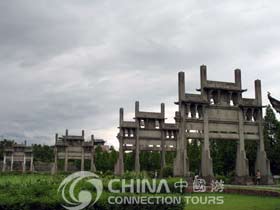
 Paifang, also called Pailou in Chinese, is very Chinese architecture. Actually a Paifang is an archway usually made of fine wood or stone, well painted and with glazed tiles sometimes, for memory and decoration. On its middle beams, moral inscriptions by certain calligraphist, mostly preaching some norms, often can be seen. Usually, these so-called memorial structures stand in downtown areas, or before entrances of mausoleums, temples, bridges and parks. Though Paifang is deemed as memorial architecture, it has other functions: marking, decorating, honoring and spacing. Not all these archways possess all the functions; however rich cultural connotations can be explained. First, Paifang or Pailou reflects people's life aspirations in feudal times, which usually can be read from inscriptions on the beams. It exhibits folk customs of ancient China. Building Paifang was an important folklore in feudal society, while the structure itself was a carrier of ancient social customs. Paifang presents perfect harmony of ancient Chinese architectural modeling art and sculpting art, which both enjoy long history and attract interests of the world for their unique styles and artistic value. The sacred emotions of the ancient Chinese rested on Paifang too. Erecting a Paifang was a very solemn event. Various emotions, praising, honoring, commemorating, praying or blessing were materialized through those beautiful arches. The structure mirrors feudal ethics and traditional norms in ancient China. As a physical architecture of those ethics and norms, various Paifangs, such as chastity Paifang (mostly for widowed women exclusively), loyalty Paifang and filial piety Paifang, were set up all around. Paifang witnesses history. Many a Paifang was built to commemorate historical events and important historic figures, thus those structures, are of great importance in the research of Chinese history. Paifang has long become a symbol of China for its long history, rich connotation and unique art value.
Paifang, also called Pailou in Chinese, is very Chinese architecture. Actually a Paifang is an archway usually made of fine wood or stone, well painted and with glazed tiles sometimes, for memory and decoration. On its middle beams, moral inscriptions by certain calligraphist, mostly preaching some norms, often can be seen. Usually, these so-called memorial structures stand in downtown areas, or before entrances of mausoleums, temples, bridges and parks. Though Paifang is deemed as memorial architecture, it has other functions: marking, decorating, honoring and spacing. Not all these archways possess all the functions; however rich cultural connotations can be explained. First, Paifang or Pailou reflects people's life aspirations in feudal times, which usually can be read from inscriptions on the beams. It exhibits folk customs of ancient China. Building Paifang was an important folklore in feudal society, while the structure itself was a carrier of ancient social customs. Paifang presents perfect harmony of ancient Chinese architectural modeling art and sculpting art, which both enjoy long history and attract interests of the world for their unique styles and artistic value. The sacred emotions of the ancient Chinese rested on Paifang too. Erecting a Paifang was a very solemn event. Various emotions, praising, honoring, commemorating, praying or blessing were materialized through those beautiful arches. The structure mirrors feudal ethics and traditional norms in ancient China. As a physical architecture of those ethics and norms, various Paifangs, such as chastity Paifang (mostly for widowed women exclusively), loyalty Paifang and filial piety Paifang, were set up all around. Paifang witnesses history. Many a Paifang was built to commemorate historical events and important historic figures, thus those structures, are of great importance in the research of Chinese history. Paifang has long become a symbol of China for its long history, rich connotation and unique art value.

